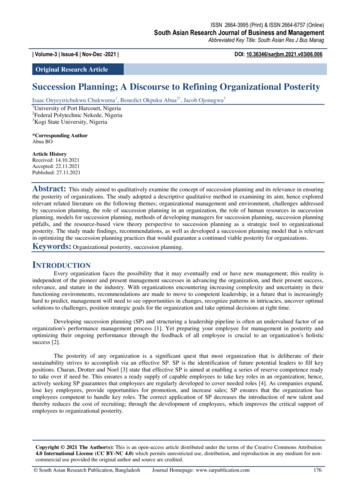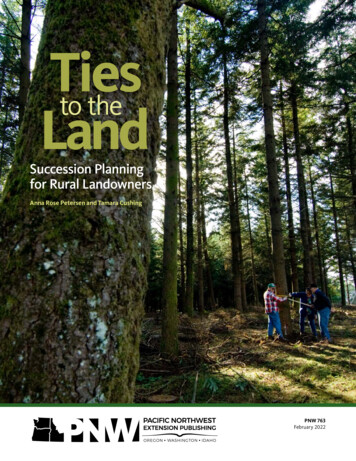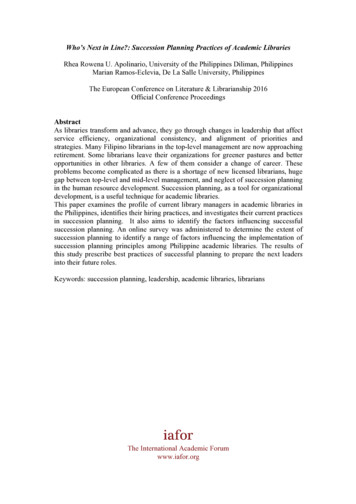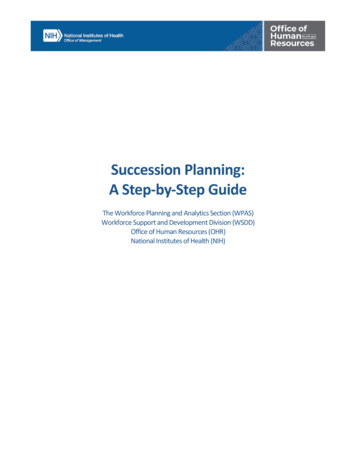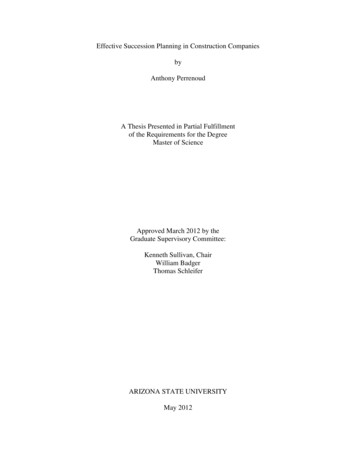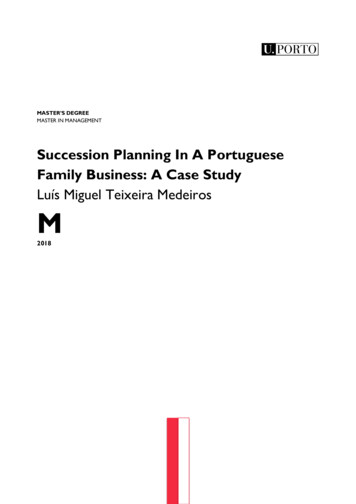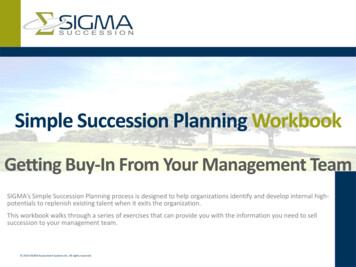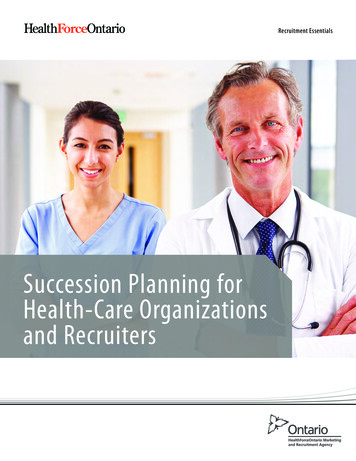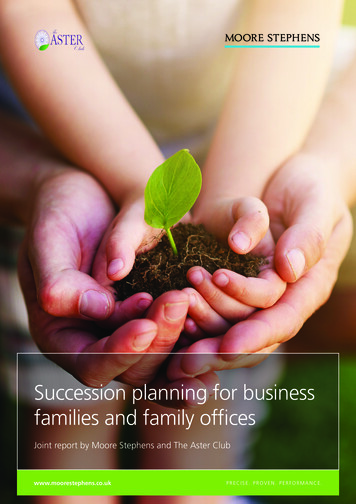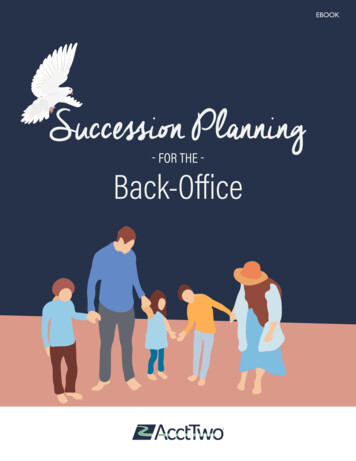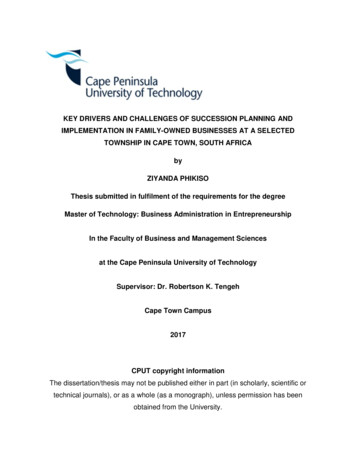
Transcription
Presenting a live 90-minute webinar with interactive Q&ABusiness Succession Planning: Estate PlanningVehicles, Common Issues, Best PracticesTUESDAY, MAY 21, 20191pm Eastern 12pm Central 11am Mountain 10am PacificToday’s faculty features:Jessica Coutré, Attorney, Freeborn & Peters, ChicagoMichael de León Hawthorne, Member, Dickinson Wright, Washington, D.C.Michael D. Whitty, Partner, Freeborn & Peters, ChicagoThe audio portion of the conference may be accessed via the telephone or by using your computer'sspeakers. Please refer to the instructions emailed to registrants for additional information. If youhave any questions, please contact Customer Service at 1-800-926-7926 ext. 1.
Tips for Optimal QualityFOR LIVE EVENT ONLYSound QualityIf you are listening via your computer speakers, please note that the qualityof your sound will vary depending on the speed and quality of your internetconnection.If the sound quality is not satisfactory, you may listen via the phone: dial1-866-961-9091 and enter your PIN when prompted. Otherwise, pleasesend us a chat or e-mail sound@straffordpub.com immediately so we can addressthe problem.If you dialed in and have any difficulties during the call, press *0 for assistance.Viewing QualityTo maximize your screen, press the F11 key on your keyboard. To exit full screen,press the F11 key again.
Continuing Education CreditsFOR LIVE EVENT ONLYIn order for us to process your continuing education credit, you must confirm yourparticipation in this webinar by completing and submitting the AttendanceAffirmation/Evaluation after the webinar.A link to the Attendance Affirmation/Evaluation will be in the thank you emailthat you will receive immediately following the program.For additional information about continuing education, call us at 1-800-926-7926ext. 2.
Program MaterialsFOR LIVE EVENT ONLYIf you have not printed the conference materials for this program, pleasecomplete the following steps: Click on the symbol next to “Conference Materials” in the middle of the lefthand column on your screen. Click on the tab labeled “Handouts” that appears, and there you will see aPDF of the slides for today's program. Double click on the PDF and a separate page will open. Print the slides by clicking on the printer icon.
Business Succession Planning:Estate Planning Vehicles,Common Issues, Best PracticesMichael Hawthorne, Mike Whitty, and Jessica CoutréTuesday, May 21, 2019, 1:00pm-2:30pm EDTCopyright 2019 by the authorsThe statements in these slides and in this presentation are those of the authors,and should not be attributed to either their law firms or their clients.
Speaker Bio: Michael HawthorneMICHAEL DE LEÓN HAWTHORNEAttorney at LawDickinson Wright LLPInternational Square1825 Eye Street N.W. Suite 900Washington, D.C., DC 20006202-731-3327 direct844-670-6009 ne?tab 0Michael Hawthorne is a Member and Chair of the Washington D.C. Corporate Practice atDickinson Wright. He is nationally recognized in the areas of corporate law, mergers andacquisitions (M&A), and securities law. Michael has extensive experience working onsecurities matters and helps his clients comply with related laws and regulations.Michael assists public and private companies to successfully implement corporatestructures that allow them to grow their business through capital formation, M&A, and jointventuring with potential business partners. He advises startups and companies preparingfor a public or private offering, ensuring these companies are structured properly in allstages of their development. He has represented seed, venture, and private equityinvestment funds worth more than 6 billion. He also regularly represents privateinvestment firms seeking investment opportunities and companies raising capital. Oneither side of these transactions, he taps his extensive knowledge of complex securitiesand financial instruments to discover, document, and close deals that achieve, andfrequently exceeds, his client's goals. Michael has handled more than 50 privateplacements, more than 25 public offerings, and hundreds of M&A deals and hasrestructured numerous domestic and international companies.Michael's clients are involved in a wide range of industries, including manufacturing,telecommunications, distribution, natural resources, health care, energy, restaurant, andtechnology. He represents many family-owned businesses and works collaboratively withtheir advisors to provide cross-disciplinary approaches that address issues that areunique to these clients, such as succession planning, trusts and estate preparation, andbalancing the needs of multiple generations and other family members. Michael is a longterm member of the International Association of Attorneys for Family-Held Enterprises,Inc. (AFHE), and was the President and Chair for AFHE for seven years.66
Speaker Bio: Michael D. WhittyMICHAEL D. WHITTYAttorney at LawFreeborn & Peters LLP311 South Wacker Drive, Suite 3000Chicago, Illinois 60606-6679(312) 360-6192 direct(847) 363-6010 /attorney/michael-d-whittyMichael Whitty (“Mike”) is a Partner in the Corporate Practice Group. He concentrateshis practice in estate planning, taxation, and estate and trust administration. Mikerepresents business owners, principals of venture capital and private equity funds, keyexecutives, investors, and other high net worth individuals in planning for thepreservation and transfer of their wealth.Specifically, he advises individuals and fiduciaries in the design and drafting of estateplans, wills, trusts, lifetime gifts, premarital agreements, and other estate planningdocuments. Mike has extensive experience with various types of trusts, family limitedpartnerships, corporate recapitalizations, shareholders’ and redemption agreements,private annuities, installment sales, intra-trust sales and other transactions, selfcanceling installment notes, and net gifts. He also reviews and manages estate andgift tax returns, including complex reporting and valuation issues.Additionally, Mike consults with executors, administrators, guardians, and trustees inprobate and trust administration. He supervises the drafting of estate administrationdocuments and the filing of pleadings, motions, and accountings with probate courts.He also advises clients in connection with litigation involving disputes betweentrustees and beneficiaries and in contested trust and tax matters, and he has servedas an expert witness in such cases.Mike is a fellow of the American College of Trusts and Estates Counsel (ACTEC), afellow of the Family Firm Institute (FFI), and the Vice-President and Treasurer ofAttorneys for Family-Held Enterprises (AFHE).77
Speaker Bio: Jessica CoutréJESSICA COUTRÉAttorney at LawFreeborn & Peters LLP311 South Wacker Drive, Suite 3000Chicago, Illinois 60606-6679(312) 360-6475 y/jessica-coutréJessica Coutré is an attorney in the Corporate Practice Group. Jessica concentratesher practice in estate planning, trust and estate administration and controversy, andrelated gift, estate, and generation-skipping transfer tax issues for high and ultra-highnet worth individuals, their families, and their businesses.Jessica advises clients on the structuring and implementation of advanced estate planning strategies, supplemental needs trustsfor disabled loved ones, pre- and post-nuptial agreements, and charitable planning through the creation of private foundations,public charities, and charitable trusts. She works closely with clients to advise them regarding asset protection planning, businesssuccession planning, and fiduciary income and estate and gift tax issues.Jessica administers taxable and non-taxable decedent’s estates and related trusts including the settlement of creditor claims,filing estate tax returns, and preparing trust accountings. When estate and trust matters escalate into controversies, Jessicaworks to find practical solutions and family reconciliation through the use of nonjudicial settlement agreements and other prelitigation resolution techniques as well as representing clients in will and trust contest and trust litigation matters.In recognition for her legal work in the area of trusts and estates, Jessica has been selected as a 2018-2020 fellow for theAmerican Bar Association – Real Property, Trust & Estate Section.88
Importance of Succession Planning There are few events in the life of a business that are ascritical as replacing an owner. Without a firm succession plan in place, there is a highrisk that the company will fail. Replacing an owner is not only stressful on thesuccessor owner, but also the:o employees,o customers,o suppliers, ando other stakeholders in the business.9
Role of Advisors in Succession Planning Advisors can provide valuable guidance andimplementation for several essential aspects ofsuccession planning for a private business. We will be discussing:o corporate governance documents and matters,o estate planning vehicles,o financial issues, ando related subjects.10
Benefit to Attendees This discussion will help you market to existing clients andprospective clients early on in the process, which will helpyield better results for everyone. This webinar’s panel believes strongly in a crossdisciplinary approach in working with clients anddeveloping a plan early on in the process.o Cross-Disciplinary (or Multi-Disciplinary),consistent with mission ofAttorneys for Family-Held Enterprises (AFHE): Corporate/Business Lawyer and Estate Planner Tax Planner and/or CPA Succession Consultants11
Overview of the Succession Process andMaking the Case for Succession Planning Our panel will provide counsel in developing andimplementing such a process and an appropriatesuccession plan. The panel will discuss how to build a business case andaddress other needs to help create a successfulsuccession plan and process.12
Overview of Topics DiscussedWe will review these and other relevant topics: Why is succession planning important for allbusinesses? Distinction of Succession Planning from Exit Planning What is an estate planner’s role in drafting andmaintaining a business succession plan? What are the common types of corporate governancestructures and estate planning vehicles used insuccession planning?13
Overview of Topics Discussed, continued Why is the process important? Which employees should be included in a company’ssuccession plan? How to build a cross-disciplinary collaborativeapproach to help in the succession plan and itsimplementation. Estate Planning Vehicles Compatible With andComplementary to Succession Planning14
Importance of Having a Plan –Even One You Know Will Change The Voyage: a succession plan is not merely onetransaction, it is a process, or voyage. Survival of Planso “No plan survives first contact with the enemy.”attributed (in variations) to Helmuth von Moltkeo “In preparing for battle, I have always found that plans are useless butplanning is indispensable.” attributed (in variations) to Dwight D.Eisenhower Charting a Course: Better to chart a course that mayneed to be corrected later, than to set out adrift without adestination in mind. Failure to Plan Planning to Fail?15
Succession Planning as a Process;Importance of the Process Succession planning is a process, not merely a step or atransaction. The first plan is rarely the last. Succession planning is dynamic, it is collaborative, andit requires input from multiple stakeholders andadvisors in addition to the key decision-makers. It is true that a bare-bones, stop-gap, preliminarysuccession plan can be designed and implemented in afairly short time without all the input necessary for anoptimal, fully-developed plan, and this preliminary plan isbetter than nothing. If the preliminary plan is all a clientcurrently has the time and money budget for, help themdo that while clearly communicating the need to do more.16
Identification of Primary Goals andConsiderations Identification of Client (founder vs. company vs. othershareholders vs. founder’s family members) Succession Plans versus Other Exit Strategies(not mutually exclusive) No two situations are exactly alike; different owners will requiredifferent succession plans.o One form if intent is to retain the business for the long termo Another form of plan if owner expects to sell before turning over controlor ownership Identify where the business owner would like to be —you can’t chart a course unless you know the destination. Perform triage on all the things you could do, and focus first onthose things you must do.17
Identification of Primary Goals andConsiderations, continuedTwo principles the owner must understand: “Fair” does not necessarily mean “equal”when it comes to allocating and distributing interests in thebusiness among family members(or among non-family key employees). Family employees can rarely do it all.18
Failure to Make anEstate PlanConsistent With theSuccession Plan“Fair” does notnecessarily mean“equal.”“I Can’t Tell You How Pleased I was toLearn That Dad Left All of Us Equal Shares . . .”Danco / Jonovic, ”Someday It’ll All Be . . . Who’s?”1919
Causes of Wealth Dissipation20
Business Considerations Needs of the business:o Financial Capital (cash flow, equity investment, creditand access to more credit),o Human Capital (talent and expertise)o plenty of Strategyo Ideas and Technology Lenders, equity investors, non-family key executivesgenerally welcome and encourage a succession plan.21
Corporate Matters Affecting Succession Technology Datarooms Insurance Banking Relationships Diversification Compliance with Securities Laws Insurance:o Directors & Officerso Errors & Omissionso Fraud & Securities Law22
Accounting and Financial ReportingMatters Affecting Succession Financial Statements: audited, nor non-audited?o What does the business currently have?o What does the business truly need?o Are records accurate and complete? Financial Responsibility andProfessional Skillso Does the company have or needa CFO? Operational Skills and Human Capitalo Who can run the businesso Does the company have or need a COO?23
Income Tax Considerations Take income taxes into account.o Sometimes, income taxes are merely a cost of doingbusiness.o Sometimes, income taxes might be a show-stopper(especially for a very large taxable gain) Income taxes are more likely to affect how youapproach a problem, not whether you decide toapproach the problem in the first place.24
Income Tax ConsiderationsNon-exhaustive list of key income tax provisionsaffecting succession planning: Tax Status of Primary Entity/Entities:o C Corporation Taxation (Subchapter C)o Partnership Taxation (Subchapter J)o S Corporation Taxation (Subchapter S) Section 199A, Passthrough Deduction Section 303, Post-Mortem Stock Redemption Section 409A, Non-Qualified Compensation Section 1202, Small Business Stock Exclusion25
Cash Flow Considerations Cash flow is critical, both for the business and for thebusiness owner.o Plans requiring too much cash flow out of thebusiness can put too much strain on the business.o Plans that fail to address the departing owner’scontinuing cash flow needs (especially retirement andfinancial planning) could ruin the owner or bring theplan to a halt.26
Choice of Entity Considerations Limited Liability Companies: very flexible; passthrough Limited Partnerships: fairly flexible; passthrough C Corporations:o Low internal tax rateo Distributions (dividends) subject to taxo Eligible for Section 1202 small business exclusion;tax-free sale of shares is possible S Corporations: passthrough; some other taxadvantages27
Choice of Entity Considerations Some entities allow for easier transitions and transfersthan others. Example: Subchapter S corporations have strictrequirements for:o number of shareholders,o a single class of stock (ignoring voting differences),ando type of shareholders: (only US residents* and onlycertain types of trusts; generally no entities)* Nonresidents can now be potential appointees withoutdisqualification28
Governance IssuesGovernance Structure: Balancing Competing Needs forDecisive Action, Accountability, and Flexibility No single arrangement is right for all businesses, all ofthe time.o Formality or informality,o Rigid or flexible structure,o With or without ample checks and balances, ando Decisions by a consensus of key personnel,or by a single decision maker.o Control balanced with Ownershipo Percentage interests, or Units/Shares29
Shareholders Agreement Transfer Restrictions – A major function of shareholdersagreements is to restrict transfers, whether by:o outright prohibition (may not be enforceable),o a right of first refusal or right of first offer,o a call option held by the company or other ownerso a put option held by a departing owner, oro some combination thereof. Some agreements facilitate transfers to “permittedtransferees” (family members, other shareholders, trusts).30
Leadership Succession Planning,Including Backup Plans Just as a naval ship has a clear chain of command, thebusiness leader should have a backup plan. The process is more involved than simply making adesignation on paper (although that’s a necessary firststep). The designated successor should become a realunderstudy to the current business leader.31
The Value of a “Fire Drill” or “Dry Run” At some point the succession and estate planning for the businessowner will be sufficiently developed that a “dry run” would beworthwhile.o A “dry run” would involve the business owner, key managers,employees, and advisors, and possibly the owner’s spouse andmature family members.o A hypothetical timeline of events involving the business owner’smajor disability, death, or both would set up the scenario.o The planners and advisors would then walk through how eachevent in the scenario affects the business and the family, giventhe current planning and legal structures in place.o This rehearsal process may uncover previously unrecognizedgaps in the planning, as well as preparing the family and otherstakeholders for what to expect.32
Business Operation, Succession, andGovernance Documents Operating Agreement or By-Laws Shareholders Agreement Mechanism for Resolving IntermediateDeadlocks Designation of Successor Managers/Executives Alternative Dispute Resolution Buy-Sell Agreement (details below)33
Business Operation, Succession, andGovernance Documents, continuedBuy-Sell Agreement (or Buy-Sell Provisions of a ShareholdersAgreement), including: To protect against ownership interests going to outsiders, provisionsfor covering the “Five Ds,” events that trigger a buy or sell obligation,spelling out sources of funding and timing of payments for each:o Death - redemption, call, or put rights at fair market value(if estate tax issues to be avoided)o Disabilityo Departures (voluntary and involuntary, including retirement)o Divorceo Debts/bankruptcy Drag-along and Tag-along Rights Ultimate Buyout for Resolving Irreconcilable Deadlocks34
Funding the Buy/Sell Provisions;Source and Timing of PaymentsLiquidity is necessary to purchase shares of adeparting owner. Buy-Sell Agreement provisions are practically uselesswithout a source for at least partial liquidity availablewhen a contingent buy-sell provision is triggered. An all-cash buyout may not be necessary, or desirable.“Seller Financing” (purchase of some or all the departingowner’s interest for an installment note) may be thebest solution for all parties.35
Funding the Buy/Sell Provisions;Source and Timing of Payments, continued Death. For purchases at death, life insurance is useful and arrivesat the right time, but it’s not so useful for other events that cantrigger a buy-sell agreement.o Available insurance is used for full purchase or at least a downpayment, with any balance being seller-financed.o For a redemption type of buy-sell, the insurance is owned by andpayable to the entity that will redeem interests from the estate.o For a cross-purchase type of buy-sell, consider using a separate trustor LLC to own insurance. Disability. Traditional disability insurance may not go far enoughto provide liquidity for a departing disabled owner, but could providea down payment, with the balance seller-financed.36
Funding the Buy/Sell Provisions;Source and Timing of Payments, continued Departures: If not the full amount, at least a down payment, couldbe payable with reserve funds set up in (usually non-qualified)deferred compensation; balance is seller-financed. Divorce: If no buyout of the current owner’s divorcing spouse canbe negotiated, a transfer to that spouse is an involuntary transaction,and as such the company has neither the motive nor the liquidity toeven make a down payment; buyout is 100% seller financed. Debts/Bankruptcy: When a buy-sell agreement is triggered by abankruptcy, a transfer to a creditor or bankruptcy estate is aninvoluntary transaction, so buyout is 100% seller financed. An alternative or supplemental method to build up cash reserves foreventual buyouts is the equity sinking fund (described below).37
Trusts or LLC to Own Insurance forCross-Funded Buy-Sell Agreements The advantage of the cross-selling buy-sell approach over theredemption approach is for income tax basis.o With the redemption approach, the entity buys the interest ofthe departing owner;the remaining owners continue to have their original basis intheir ownership interest, which has just increased in value afterthe redemption.o With the cross-sell approach, the remaining owners (oftenthrough a trust or LLC) acquire interests from the departingowner by purchase, with a stepped up basis for the acquiredportion.38
The “Equity Sinking Fund”:Cash for Redemptions (MDW) Most of us have heard of a debt sinking fund, where cash thatcould be put to immediate use to pay down debt early is insteadreserved to pay off the debt at maturity.o One example of when a debtor would prefer to build up a debt sinkingfund, rather than pay down debt, would be when interest rates had risenafter the debt had been incurred, and the debtor could make a decentreturn on the cash reserves in the sinking fund while retaining theflexibility of keeping low-interest debt outstanding. An equity sinking fund is a cash reserve built up over time toredeem shareholders, using funds that might otherwise go out individends.o Another name for an equity sinking fund might be a“Strategic Liquidity for Unification of Share Holdings” fund –but “SLUSH Fund” does have some unfortunate connotations.39
The “Equity Sinking Fund” continued The equity sinking fund is a technique used in connection withsome buy-sell agreements. It is often coupled with a specific program to allow shareholders to“put” all or a portion of their shares to the company every few years,or when the company had built up sufficient cash reserves in theequity sinking fund to be able to fully redeem a shareholder, orredeem a substantial portion of shares from multiple shareholders. Although not required, the terms of the share redemption programusing the equity sinking fund could be set up to favor:o complete redemptions over partial redemptions, ando those transactions that qualified for favorable tax treatment asredemptions over those that might be characterized as disguiseddividends.40
The “Equity Sinking Fund”continued The shareholders will need to be persuaded of thebenefits of the equity sinking fund, and that the fund is agood use of cash that might otherwise go out as currentdividends. However, with any business expecting a long-term ormulti-generational ownership transition, the likelihood ofneeding to redeem (or cross-purchase) businessinterests becomes a matter of “not if, but when.” The sooner an equity sinking fund or similar program isset up, the longer it will have to build up funds to buy outparticularly large interests.41
Other Options for Liquidity Sell of the entire company Sale of a minority or majority interest (a “roll-over”transaction) Expand “Bolt On” Acquisitions Debt Financing: relying on banking relationshipsfor debt / EBITDA loans Investment Bankers Optionality42
Spin-Off of Separate Business Lines When family owner-managers participate in differentseverable business lines, giving separate business lines to separate family ownermanagers (a form of total or partial horizontaldivestiture) can:o provide good incentives, by structuring compensationto the key leaders of each business line to rewardsuccess, ando reduce (or at least postpone) future conflicts.43
Separation of Capital Assets fromOperational Assets Consider “spinning off” major capital assets:o Lando Property, plant, equipmento Intellectual propertyand distribute those capital assets (or entities set up to hold thoseassets) to the inactive shareholders A form of vertical divestitureo Does not eliminate future conflicts between inactiveshareholders and active shareholders, but o . it should reduce the number, scope, and frequency ofconflicts. May involve or affect: debt, bank financing, seller financing,secured vs. unsecured44
Recommended Preliminary Step:The Voting/Non-Voting Recapitalization Implemented before any transfers for estate planning orsuccession planningo Almost always helpful, as transfers of substantial economicinterests can be made without affecting controlo Rarely hurts Transfers of non-voting interests:o Do not have the same estate tax considerations,i.e. Section 2036(b)o May be eligible for an additional valuation discount45
Recommended Preliminary Step:The Voting/Non-Voting Recapitalization Typically a stock dividend (or LLC unit equivalent)issuing 9 or 19 shares/units of non-voting for eachexisting share/unit of voting. Covenants and contract provisions regarding change ofcontrol should reflect the voting/non-voting distinction, asa change in majority equity ownership is not necessarily achange of control. In certain circumstances, non-voting stock might have aright to be converted to voting stock46
Core Estate Planning Documents:Necessary, but Not Sufficient, for aBusiness OwnerUsual components of a “Core”Estate Plan: Pour-Over Will Revocable Trust Durable General Power of Attorney for Property Health Care Power of Attorney Living Will HIPAA Authorization47
Core Estate Planning Documents:Necessary, but Not Sufficient, for aBusiness OwnerUsual components of a “Core”Estate Plan for a Business Owner: Pour-Over Will Revocable Trust with Special Business Trustee Durable General Power of Attorney for Property Special Power of Attorney for Business Health Care Power of Attorney Living Will HIPAA Authorization48
Common Transfer Techniques Once the business owner has decided to pass on the closely-heldbusiness to family members, the owner can decide to give some or allaway during life or hold it all until death. Initial Observation: Cheaper to Give Than to Bequeatho For various tax reasons: fractional interest valuation discounts, gift tax calculation on a tax-exclusive basis, and the benefits of shifting growth outside the taxable estate,it is much cheaper to transfer by lifetime gifts than by bequests atdeath.o To anticipate the business owner’s question,this can be done without surrendering control!(ex., with a voting/non-voting recapitalization)49
Give Early, Give Often Especially when leverage gifting techniques are used,time can be an advantage. If the business is expected to grow ( as it should be, ifthe owner wants to pass it on), then an early gift cantake advantage of lower gift tax valuations.50
Estate Tax Considerations, Generally Huge increase in lifetime gift and estate tax exemptionsfrom 2001 ( 1MM) through 2019 ( 11.4MM) Portability of the unused estate tax exemption Status of Current Legislation:o Current exemption of 11.4MMwill sunset after 2025, revert to 5MM plus inflation adjustments after 2010o Proposals from some candidates to lower theexemption even further, to 3.5MM or less Estate tax calculated on what decedent owned, not whatbeneficiaries receive51
Estate Planning Transfers and TechniquesThat Work Well for Closely HeldBusinesses and Succession Planning Trusts or LLC to Own Insurance for Cross-Funded BuySell Agreements(discussed previously) Leveraged Transactionso Grantor Retained Annuity Trust (“GRAT”)o Installment Sale to Grantor Trusto Mortality Plays: SCINs, Private Annuities Preferred / Common Recapitalization Opportunity Shifting Transfers Using Derivatives52
Leveraged Techniques for Transfersof Business Interests Grantor Retained Annuity Trusts (“GRATs”) Loans and Sales to Grantor Trusts Mortality Plays (Private Annuities and SCINs)53
Grantor Retained Annuity Trusts(“GRATs”) Basic concept of a GRAT:o donor transfers an asset such as a business interestto a trust,o while retaining an offsetting annuity interest, with anet present value (“NPV”) equal to (or almost equalto) the value of the transferred asset;o the net value transferred is zero, or as close to zeroas the donor can accept. Allows the donor to shift future *growth* without makinga substantial current gift. Functionally like a non-recourse loan to donees.54
General Explanation of Grantor RetainedAnnuity Trust and “Zeroed-Out GRAT”GRATGrantor“Freeze” TechniqueTransferredAssetsHolds transferred assets subject Appreciation above the Section7520 Rate flows to theto obligation to pay the Annuity:AnnuityInterest(series ofpayments) StockReal EstateInvestmentsLLC InterestsRemainderAfter Annuity“Zeroed-Out GRAT” means:Present Value of the Annuity Interest(calculated using the Section 7
Succession Planning as a Process; Importance of the Process Succession planning is a process, not merely a stepor a transaction. The first plan is rarely the last. Succession planning is dynamic, it is collaborative, and it requires input from multiple stakeholders and advisorsin addition to the key decision-makers.
